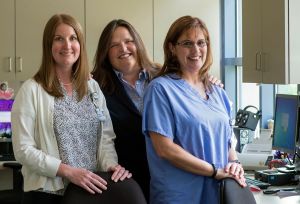June 20, 2018
June 20, 2018

7 Facts About Hernias
Imagine an inner tube poking a hole through a bike tire. That’s what a hernia looks like.
A hernia is a common term that refers to a bulge or protrusion of a body tissue or organ through the structure that normally contains it. Dr. Michelle Helms, a general surgeon with Cooley Dickinson Medical Group General Surgical Care has repaired hundreds of hernias in her career.
Hernias are so common, Dr. Helms says, that she and her partners treat hundreds of them each year. “As long as there are no symptoms, you can take a ‘watch and wait’ approach to a hernia. But if you notice pain, or if a bulge increases in size, talk to your doctor.”
In recognition of National Hernia Awareness month, Dr. Helms shares 7 facts to raise awareness of this common condition.
1. Hernias impact both men and women, but are more common in men. Babies can also get hernias, too, which means their abdominal walls haven’t fully formed and tissue escapes through a natural weak spot in their bellies.
2. There are different types of hernias. The most common are inner groin (inguinal), belly button (umbilical), and those that result from an abdominal incision from surgery.
3. People experience a range of symptoms with hernias. Most often, it’s pain, swelling or discomfort at the hernia site.
4. A weekend of moving heavy furniture or stepping up your gym routine could cause a hernia. Think heavy lifting or strenuous activity. Poor nutrition, obesity, and smoking can all weaken the abdominal wall and increase your chances of a hernia.
5. Hernias are repaired with surgery. And surgery usually involves mesh, which often prompts questions from my patients. I tell them that the mesh is placed outside of the belly cavity and is not in contact with your organs. The purpose of the mesh is that you want scar tissue to grow into the mesh so it grows a reinforcing layer in the area that was weakened.
6. Lumps and swelling? Take notice. I tell my patients that they know their own bodies. If they notice something has changed or just isn’t right, they should talk to their doctor.
7. Prevention: Eat a healthy, balanced diet; exercise regularly; use correct form when lifting heavy objects; and see your provider if you have a persistent cough.
Dr. Michelle Helms is board certified in general surgery from the American Board of Surgery. On taking care of patients, she says, “I believe in creating a reassuring and comfortable experience for my patients, and partnering with them to achieve the best outcomes possible. I very much look forward to meeting new patients and providing excellent care in a wonderful community.”


What about hiatal hernias? Is there surgery for that kind too?
Yes, Dr. Helms reports that there is surgery for those types of hernias, too. Speak with your health care provider if you have questions about hiatal hernias. Thanks for your comment!